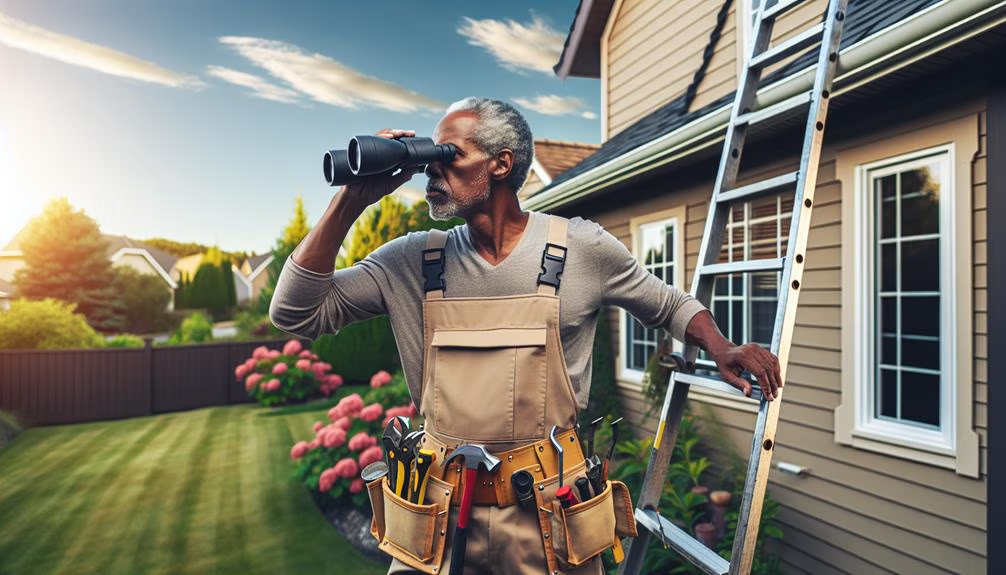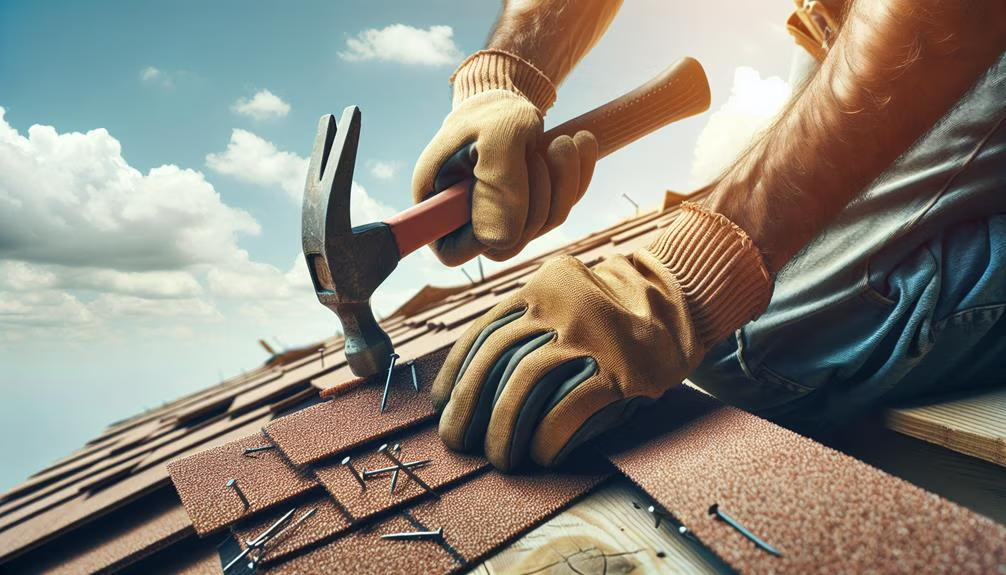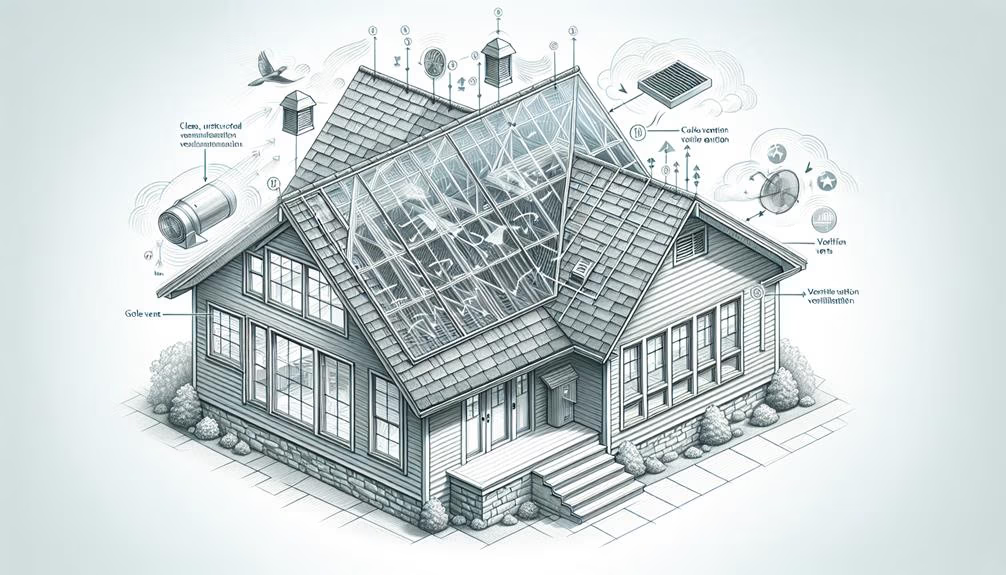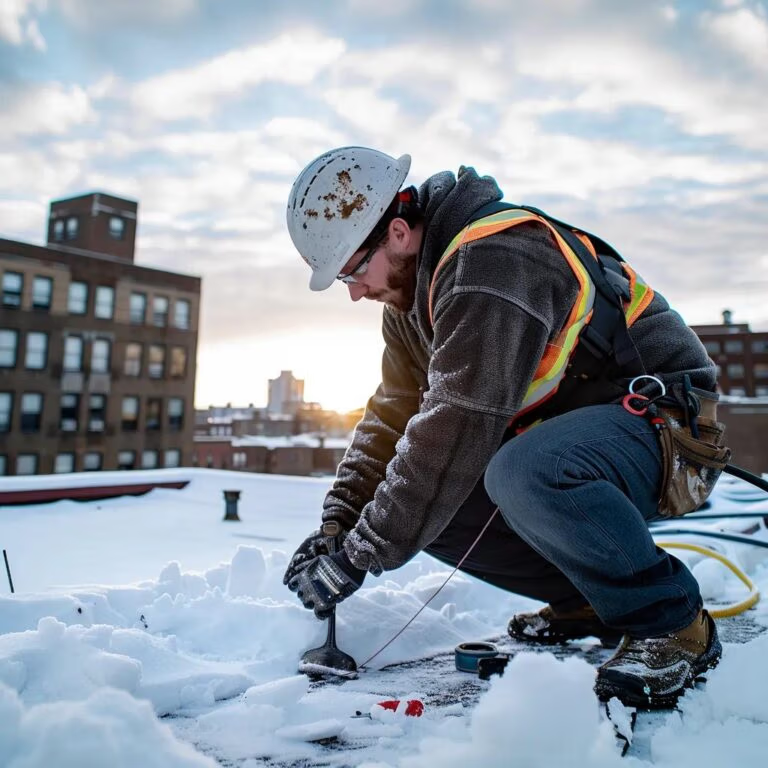Proper roof maintenance is vital for extending its lifespan and preventing expensive repairs. Conduct biannual inspections, focusing on signs of wear like cracked or missing shingles and damaged flashing around chimneys and vents. Clean gutters at least twice a year to prevent blockages and water damage. Trim trees to avoid overhanging branches that can damage shingles. Regularly inspect the attic for signs of water damage or mold. Repair damaged shingles promptly and check that roof flashing is intact to prevent leaks. Adequate ventilation is also crucial to avoid moisture buildup. For more detailed guidance, there's much more to explore.
Key Takeaways
- Conduct biannual roof inspections to check for wear and damage, especially around chimneys and vents.
- Clean gutters at least twice a year to ensure proper drainage and prevent water damage.
- Regularly inspect and secure roof flashing to prevent leaks and structural damage.
- Trim overhanging branches to prevent debris accumulation and potential roof damage.
- Ensure proper attic ventilation to prevent moisture buildup and regulate indoor temperatures.
Regular Roof Inspections

Regular roof inspections are a critical component in prolonging the lifespan of your roofing system and preventing costly repairs. These inspections should ideally be conducted biannually—once in the spring and once in the fall—to identify any potential issues before they escalate. During these inspections, homeowners or professionals should check for common signs of wear and tear, such as cracked, missing, or curling shingles, which can compromise the roof's integrity.
Additionally, attention should be paid to the flashing around chimneys, vents, and other roof penetrations, as these areas are particularly susceptible to leaks. Inspecting the attic for signs of water damage or mold growth can also be revealing, as these issues often indicate a compromised roof. It's important to ensure that there is no debris accumulation on the roof, as this can trap moisture and lead to deterioration.
Regular inspections not only help in early detection of problems but also in maintaining warranty conditions, as many roofing manufacturers require documented maintenance. By keeping a detailed record of inspections and any necessary repairs, homeowners can better manage their roof's condition and longevity.
Cleaning the Gutters
Cleaning the gutters is a crucial part of roof maintenance to prevent water damage and ensure the longevity of your roofing system. Regularly removing debris such as leaves and twigs not only maintains proper drainage but also helps prevent blockages that can lead to water overflow and structural damage. By ensuring the gutters are clear and functioning correctly, you can safeguard your home from potential water-related issues.
Remove Debris Regularly
One crucial aspect of maintaining a roof is the regular removal of debris from gutters to prevent water damage and ensure proper drainage. Over time, leaves, twigs, and other debris can accumulate in gutters, leading to blockages that impede the flow of rainwater. These blockages can cause water to overflow, potentially damaging the roof, fascia, and even the foundation of your home.
To effectively remove debris, it's recommended to clean the gutters at least twice a year, ideally in the spring and fall. Use a sturdy ladder and appropriate safety gear such as gloves and eye protection. Begin by manually removing larger debris with a small scoop or trowel, followed by rinsing the gutters with a garden hose to clear finer particles. A gutter cleaning attachment for your hose can make the process more efficient.
Regular inspections are equally important to identify any signs of wear or damage, such as rust or loose fasteners, which can be promptly addressed. Integrating a gutter guard system can also help minimize debris buildup, reducing the frequency of manual cleaning. By maintaining clean gutters, you protect your roof and home from potential water damage, ensuring long-term durability and performance.
Ensure Proper Drainage
To maintain optimal roof health, it is imperative to ensure that gutters are consistently free from obstructions to facilitate proper drainage. Clogged gutters can lead to water pooling on the roof, which can cause leaks, structural damage, and even mold growth. Therefore, regular cleaning and maintenance of gutters play a crucial role in protecting your roof and home.
Firstly, inspect your gutters at least twice a year, ideally during spring and fall. Use a sturdy ladder to safely access the gutters, and wear gloves to protect your hands from debris. Remove leaves, twigs, and other accumulated materials using a small garden trowel or a gutter scoop. For more thorough cleaning, consider using a hose to flush out remaining dirt and ensure water flows freely through the downspouts.
Additionally, check for any signs of damage, such as rust, holes, or sagging sections, and address these issues promptly. Installing gutter guards can also be a worthwhile investment, as they minimize debris accumulation and reduce the frequency of cleaning required.
Trimming Overhanging Branches

Overhanging branches pose a significant threat to the integrity of your roof, making regular trimming a crucial maintenance task. Branches that extend over your roof can cause several issues, from physical damage during storms to gradual wear over time. The friction from branches rubbing against shingles can erode roofing materials, shortening their lifespan. In addition, falling leaves and debris can clog gutters, leading to water accumulation and potential leaks.
To effectively trim overhanging branches, start by identifying which trees pose the most risk. Focus on branches that are within ten feet of your roofline. Use appropriate tools such as pruning shears, loppers, or a tree saw, depending on the branch size. Safety should be your top priority; if the branches are high or difficult to reach, consider hiring a professional arborist.
Moreover, regular inspections can help spot new growth before it becomes problematic. Trim branches in late winter or early spring when trees are dormant; this minimizes stress on the tree and promotes healthier growth. By maintaining a clear perimeter around your roof, you not only protect your roofing materials but also enhance the overall lifespan and appearance of your home.
Checking for Roof Leaks
Identifying and addressing roof leaks promptly is essential for maintaining the structural integrity and longevity of your home. Regular inspections can help you catch leaks early before they cause significant damage.
Begin by checking the attic for signs of water intrusion, especially after heavy rains. Look for water stains, mold, or damp insulation. These are clear indicators that water is penetrating your roof. Use a flashlight to spot any dark or discolored patches.
Next, inspect the roof itself. Pay close attention to areas around chimneys, skylights, and vents, as these are common leak points. Examine the flashing, which is the material that seals joints. Damaged or corroded flashing can easily allow water to seep in.
It's also crucial to inspect the roof's surface for any visible signs of damage. This includes missing, cracked, or curled shingles. Even small issues can lead to leaks over time if not addressed.
Lastly, consider hiring a professional to conduct a thorough inspection annually. Their trained eye can spot potential problems that you might overlook. Regular maintenance and early detection are key to preventing costly repairs and ensuring your roof remains in optimal condition.
Repairing Damaged Shingles

When it comes to repairing damaged shingles, addressing the problem promptly is crucial to prevent further deterioration and potential leaks. Begin by inspecting the extent of the damage; often, this involves looking for cracks, curling, or missing shingles. Immediate action can save time and money and prevent more severe issues down the line.
First, gather the necessary tools: a pry bar, hammer, roofing nails, and replacement shingles. Carefully lift the damaged shingle using the pry bar, ensuring you do not damage adjacent shingles. Remove any remaining nails from the damaged shingle and slide the new shingle into place. Secure it with roofing nails, ensuring they are flush with the shingle surface but not overly tight, which can cause cracking.
For minor cracks or small areas of damage, roofing sealant can be an effective temporary solution. Apply the sealant under the crack and press down to ensure it adheres well. Always check the manufacturer's guidelines for the specific type of shingles used on your roof.
Maintaining Roof Flashing
Maintaining roof flashing is essential to prevent water infiltration and ensure the longevity of your roof. Begin by inspecting the flashing for any signs of damage, which can lead to leaks. Regularly clean debris and secure any loose sections to maintain its effectiveness.
Inspect for Damage
To ensure the longevity of your roof, it is crucial to regularly inspect the flashing for any signs of damage or wear. Flashing, typically made of metal, serves as a protective barrier at the joints and edges of the roof, preventing water from seeping into the underlying structure. Given its critical role, any compromise in its integrity can lead to significant issues, including leaks and structural damage.
Begin your inspection by closely examining areas where the roof meets vertical surfaces, such as chimneys, skylights, and vent pipes. These junctions are particularly susceptible to wear and tear over time. Look for rust, cracks, or loose sections in the flashing. Even minor damage can escalate rapidly if left unaddressed.
In addition, check around the edges of the flashing for signs of lifting or separation from the roof surface. This can occur due to weather conditions or the natural settling of the building. Utilize a flashlight to inspect less visible areas and ensure comprehensive coverage.
Regularly inspecting and promptly addressing any flashing issues can prevent costly repairs down the line. If you detect significant damage, consider consulting a professional roofer for a thorough assessment and repair.
Clean Debris Regularly
In addition to inspecting for damage, it is equally important to regularly clean debris from your roof to maintain the integrity of the flashing. Roof flashing, typically made from materials like aluminum or galvanized steel, is designed to direct water away from critical areas of the roof, preventing leaks and water damage. Accumulated debris, such as leaves, twigs, and dirt, can obstruct this vital function, causing water to pool and potentially seep into underlying structures.
To effectively maintain your roof flashing, begin by safely accessing the roof using a sturdy ladder and appropriate safety gear. Use a soft-bristled broom or a leaf blower to remove loose debris. Pay special attention to valleys, gutters, and areas around chimneys and vents where debris tends to accumulate. For stubborn dirt, a gentle rinse with a garden hose can be beneficial, but avoid high-pressure washing as it can damage the flashing material.
Regular cleaning not only ensures the flashing remains effective but also allows for early detection of potential issues such as rust or loose sections. By integrating debris removal into your routine roof maintenance, you can significantly extend the lifespan of your roof and prevent costly repairs.
Secure Loose Sections
Securing loose sections of roof flashing is crucial to preventing water infiltration and subsequent structural damage. Roof flashing, typically made from metal, serves as a waterproof barrier at joints and edges. If flashing becomes loose, it compromises the roof's integrity, allowing water to seep in and cause rot, mold, and other costly issues.
To begin, regularly inspect areas where flashing is installed, such as chimneys, skylights, and roof valleys. Look for signs of rust, corrosion, or gaps. If you notice any loose sections, immediate action is essential. Use roofing nails or screws to re-secure the flashing, ensuring it lies flat against the roof surface. For added protection, apply roofing cement or sealant to the edges of the flashing, creating a watertight seal.
When dealing with extensive damage or complex installations, consider consulting a professional roofer. They can provide a thorough assessment and ensure proper repairs. Additionally, periodic maintenance checks will extend the lifespan of your roof and flashing, saving you time and money in the long run.
Ensuring Proper Ventilation

Proper ventilation is crucial for maintaining the longevity and efficiency of your roof system. Adequate airflow prevents moisture buildup, which can lead to mold, mildew, and structural damage. It also helps in regulating indoor temperatures, thereby reducing energy costs and enhancing comfort. Ensuring proper roof ventilation involves a few key steps that homeowners should follow diligently.
Firstly, evaluate the existing ventilation system to identify any gaps or inefficiencies. Insufficient ventilation not only shortens the roof's lifespan but also poses health risks due to poor air quality. Here are several essential measures to ensure proper ventilation:
- Install Ridge Vents: These allow hot air to escape from the attic, reducing the strain on your roof.
- Use Soffit Vents: These help to draw in fresh air from outside, maintaining a balanced airflow throughout the attic.
- Check Attic Insulation: Proper insulation complements ventilation by preventing heat buildup and moisture accumulation.
- Inspect for Blockages: Ensure that vents are free from obstructions like debris or insulation material.
- Regular Maintenance: Periodic checks and cleanings of the ventilation system can preemptively address potential issues.
Removing Roof Debris
To maintain the integrity and appearance of your roof, regularly removing debris is essential. Accumulated debris, such as leaves, twigs, and dirt, can trap moisture, leading to mold growth and rot. Over time, this can compromise the structural integrity of your roof and reduce its lifespan.
Start by inspecting your roof every few months, particularly after heavy storms or the fall season when leaves are abundant. Use a sturdy ladder and ensure you have a partner for safety. Gentle sweeping with a soft-bristled broom or using a leaf blower can effectively remove loose debris. Be cautious to avoid damaging the shingles.
For stubborn debris, such as moss or algae, consider using a specialized roof cleaner. These products are designed to cleanse without harming roofing materials. Always follow the manufacturer's instructions and wear appropriate protective gear.
Don't neglect the gutters. Clogged gutters can cause water to back up, leading to roof leaks and potential water damage. Regularly clear out gutters and downspouts to ensure proper water drainage.
Frequently Asked Questions
How Often Should I Replace My Roof?
The frequency of roof replacement depends on several factors, including the type of roofing material, local climate conditions, and the quality of the installation. Generally, asphalt shingles require replacement every 20-30 years, while metal or tile roofs can last 50 years or more. Regular inspections and maintenance can extend the lifespan of your roof. Consult with a professional to assess your specific situation and determine the optimal replacement schedule.
What Are the Signs That My Roof Needs Replacement?
If your roof looks like it's been through a war, it's time to consider replacement. Key indicators include missing or damaged shingles, sagging areas, granules in gutters, and persistent leaks. Additionally, if you observe mold or moss growth, it may signal underlying moisture issues. Regular inspections can help identify these signs early, ensuring your roof continues to protect your home effectively. Consult a professional for a thorough assessment.
Can I Install Solar Panels on My Existing Roof?
Yes, you can install solar panels on your existing roof. However, it is essential to assess the roof's structural integrity and age first. A professional inspection can determine if any repairs or reinforcements are necessary. Additionally, consider the roof's orientation and shading to maximize solar efficiency. Collaborating with a reputable solar panel installer ensures proper installation and adherence to local regulations, optimizing both performance and safety.
What Are the Best Roofing Materials for My Climate?
When selecting roofing materials, it is essential to consider your specific climate. For hot, sunny regions, materials like clay or concrete tiles are ideal due to their heat resistance. In colder climates, asphalt shingles or metal roofing offer excellent durability against snow and ice. For areas with high humidity or frequent rain, consider materials like slate or composite shingles that resist moisture and mold.
How Can I Improve the Energy Efficiency of My Roof?
Improving the energy efficiency of your roof is almost as fun as watching paint dry. Start by adding proper insulation, which reduces heat loss. Next, consider installing reflective roofing materials or a cool roof coating to deflect sunlight. Additionally, ensure proper ventilation to regulate temperature. Finally, explore solar panel installation for renewable energy. These measures will make your roof an unsung hero in energy conservation.
Conclusion
In conclusion, consistent roof maintenance is critical for extending the lifespan and ensuring the integrity of a roof. Regular inspections, gutter cleaning, and timely repairs are essential practices. An interesting statistic to note is that homeowners who perform biannual roof inspections can extend their roof's lifespan by up to 50%. Implementing these maintenance strategies not only preserves the roof's condition but also prevents costly repairs and enhances overall home safety and efficiency.





